Nortel Networks Configuring Remote Access User Manual

BayRS Version 14.20
Part No. 308614-14.20 Rev 00
January 2001
600 Technology Park Drive
Billerica, MA 01821-4130
Configuring Remote Access for AN and Passport ARN Routers

Copyright © 1999 Nortel Networks
All rights reserved. Printed in the USA. January 2001.
The information in this document is subject to change without notice. The statements, configurations, technical data, and recommendations in this document are believed to be accurate and reliable, but are presented without express or implied warranty. Users must take full responsibility for their applications of any products specified in this document. The information in this document is proprietary to Nortel Networks NA Inc.
The software described in this document is furnished under a license agreement and may only be used in accordance with the terms of that license. A summary of the Software License is included in this document.
Trademarks
NORTEL NETWORKS is a trademark of Nortel Networks.
ACE, AFN, AN, BCN, BLN, BN, BNX, CN, FRE, LN, Optivity, Optivity Policy Services, Passport and PPX are registered trademarks and Advanced Remote Node, ANH, ARN, ASN, BayRS, BaySecure, BayStack, BayStream, BCC, BCNX, BLNX, Centillion, EtherSpeed, FN, IP AutoLearn, Optivity Enterprise, Optivity Internetwork, Pathman, RouterMan, SN, SPEX, Switch Node, System 5000, and TokenSpeed are trademarks of Nortel Networks.
Microsoft, MS, MS-DOS, Win32, Windows, and Windows NT are registered trademarks of Microsoft Corporation.
All other trademarks and registered trademarks are the property of their respective owners.
Restricted Rights Legend
Use, duplication, or disclosure by the United States Government is subject to restrictions as set forth in subparagraph (c)(1)(ii) of the Rights in Technical Data and Computer Software clause at DFARS 252.227-7013.
Notwithstanding any other license agreement that may pertain to, or accompany the delivery of, this computer software, the rights of the United States Government regarding its use, reproduction, and disclosure are as set forth in the Commercial Computer Software-Restricted Rights clause at FAR 52.227-19.
Statement of Conditions
In the interest of improving internal design, operational function, and/or reliability, Nortel Networks NA Inc. reserves the right to make changes to the products described in this document without notice.
Nortel Networks NA Inc. does not assume any liability that may occur due to the use or application of the product(s) or circuit layout(s) described herein.
Portions of the code in this software product may be Copyright © 1988, Regents of the University of California. All rights reserved. Redistribution and use in source and binary forms of such portions are permitted, provided that the above copyright notice and this paragraph are duplicated in all such forms and that any documentation, advertising materials, and other materials related to such distribution and use acknowledge that such portions of the software were developed by the University of California, Berkeley. The name of the University may not be used to endorse or promote products derived from such portions of the software without specific prior written permission.
SUCH PORTIONS OF THE SOFTWARE ARE PROVIDED “AS IS” AND WITHOUT ANY EXPRESS OR IMPLIED WARRANTIES, INCLUDING, WITHOUT LIMITATION, THE IMPLIED WARRANTIES OF MERCHANTABILITY AND FITNESS FOR A PARTICULAR PURPOSE.
In addition, the program and information contained herein are licensed only pursuant to a license agreement that contains restrictions on use and disclosure (that may incorporate by reference certain limitations and notices imposed by third parties).
ii |
308614-14.20 Rev 00 |

Nortel Networks NA Inc. Software License Agreement
NOTICE: Please carefully read this license agreement before copying or using the accompanying software or installing the hardware unit with pre-enabled software (each of which is referred to as “Software” in this Agreement). BY COPYING OR USING THE SOFTWARE, YOU ACCEPT ALL OF THE TERMS AND CONDITIONS OF THIS LICENSE AGREEMENT. THE TERMS EXPRESSED IN THIS AGREEMENT ARE THE ONLY TERMS UNDER WHICH NORTEL NETWORKS WILL PERMIT YOU TO USE THE SOFTWARE. If you do not accept these terms and conditions, return the product, unused and in the original shipping container, within 30 days of purchase to obtain a credit for the full purchase price.
1.License Grant. Nortel Networks NA Inc. (“Nortel Networks”) grants the end user of the Software (“Licensee”) a personal, nonexclusive, nontransferable license: a) to use the Software either on a single computer or, if applicable, on a single authorized device identified by host ID, for which it was originally acquired; b) to copy the Software solely for backup purposes in support of authorized use of the Software; and c) to use and copy the associated user manual solely in support of authorized use of the Software by Licensee. This license applies to the Software only and does not extend to Nortel Networks Agent software or other Nortel Networks software products. Nortel Networks Agent software or other Nortel Networks software products are licensed for use under the terms of the applicable Nortel Networks NA Inc. Software License Agreement that accompanies such software and upon payment by the end user of the applicable license fees for such software.
2.Restrictions on use; reservation of rights. The Software and user manuals are protected under copyright laws. Nortel Networks and/or its licensors retain all title and ownership in both the Software and user manuals, including any revisions made by Nortel Networks or its licensors. The copyright notice must be reproduced and included with any copy of any portion of the Software or user manuals. Licensee may not modify, translate, decompile, disassemble, use for any competitive analysis, reverse engineer, distribute, or create derivative works from the Software or user manuals or any copy, in whole or in part. Except as expressly provided in this Agreement, Licensee may not copy or transfer the Software or user manuals, in whole or in part. The Software and user manuals embody Nortel Networks’ and its licensors’ confidential and proprietary intellectual property. Licensee shall not sublicense, assign, or otherwise disclose to any third party the Software, or any information about the operation, design, performance, or implementation of the Software and user manuals that is confidential to Nortel Networks and its licensors; however, Licensee may grant permission to its consultants, subcontractors, and agents to use the Software at Licensee’s facility, provided they have agreed to use the Software only in accordance with the terms of this license.
3.Limited warranty. Nortel Networks warrants each item of Software, as delivered by Nortel Networks and properly installed and operated on Nortel Networks hardware or other equipment it is originally licensed for, to function substantially as described in its accompanying user manual during its warranty period, which begins on the date Software is first shipped to Licensee. If any item of Software fails to so function during its warranty period, as the sole remedy Nortel Networks will at its discretion provide a suitable fix, patch, or workaround for the problem that may be included in a future Software release. Nortel Networks further warrants to Licensee that the media on which the Software is provided will be free from defects in materials and workmanship under normal use for a period of 90 days from the date Software is first shipped to Licensee. Nortel Networks will replace defective media at no charge if it is returned to Nortel Networks during the warranty period along with proof of the date of shipment. This warranty does not apply if the media has been damaged as a result of accident, misuse, or abuse. The Licensee assumes all responsibility for selection of the Software to achieve Licensee’s intended results and for the installation, use, and results obtained from the Software. Nortel Networks does not warrant a) that the functions contained in the software will meet the Licensee’s requirements, b) that the Software will operate in the hardware or software combinations that the Licensee may select, c) that the operation of the Software will be uninterrupted or error free, or d) that all defects in the operation of the Software will be corrected. Nortel Networks is not obligated to remedy any Software defect that cannot be reproduced with the latest Software release. These warranties do not apply to the Software if it has been (i) altered, except by Nortel Networks or in accordance with its instructions; (ii) used in conjunction with another vendor’s product, resulting in the defect; or (iii) damaged by improper environment, abuse, misuse, accident, or negligence. THE FOREGOING WARRANTIES AND LIMITATIONS ARE EXCLUSIVE REMEDIES AND ARE IN LIEU OF ALL OTHER WARRANTIES EXPRESS OR IMPLIED, INCLUDING WITHOUT LIMITATION ANY WARRANTY OF MERCHANTABILITY OR FITNESS FOR A PARTICULAR PURPOSE. Licensee is responsible
308614-14.20 Rev 00 |
iii |

for the security of its own data and information and for maintaining adequate procedures apart from the Software to reconstruct lost or altered files, data, or programs.
4.Limitation of liability. IN NO EVENT WILL NORTEL NETWORKS OR ITS LICENSORS BE LIABLE FOR ANY COST OF SUBSTITUTE PROCUREMENT; SPECIAL, INDIRECT, INCIDENTAL, OR CONSEQUENTIAL DAMAGES; OR ANY DAMAGES RESULTING FROM INACCURATE OR LOST DATA OR LOSS OF USE OR PROFITS ARISING OUT OF OR IN CONNECTION WITH THE PERFORMANCE OF THE SOFTWARE, EVEN IF NORTEL NETWORKS HAS BEEN ADVISED OF THE POSSIBILITY OF SUCH DAMAGES. IN NO EVENT SHALL THE LIABILITY OF NORTEL NETWORKS RELATING TO THE SOFTWARE OR THIS AGREEMENT EXCEED THE PRICE PAID TO NORTEL NETWORKS FOR THE SOFTWARE LICENSE.
5.Government Licensees. This provision applies to all Software and documentation acquired directly or indirectly by or on behalf of the United States Government. The Software and documentation are commercial products, licensed on the open market at market prices, and were developed entirely at private expense and without the use of any U.S.
Government funds. The license to the U.S. Government is granted only with restricted rights, and use, duplication, or disclosure by the U.S. Government is subject to the restrictions set forth in subparagraph (c)(1) of the Commercial Computer Software––Restricted Rights clause of FAR 52.227-19 and the limitations set out in this license for civilian agencies, and subparagraph (c)(1)(ii) of the Rights in Technical Data and Computer Software clause of DFARS 252.227-7013, for agencies of the Department of Defense or their successors, whichever is applicable.
6.Use of Software in the European Community. This provision applies to all Software acquired for use within the European Community. If Licensee uses the Software within a country in the European Community, the Software Directive enacted by the Council of European Communities Directive dated 14 May, 1991, will apply to the examination of the Software to facilitate interoperability. Licensee agrees to notify Nortel Networks of any such intended examination of the Software and may procure support and assistance from Nortel Networks.
7.Term and termination. This license is effective until terminated; however, all of the restrictions with respect to Nortel Networks’ copyright in the Software and user manuals will cease being effective at the date of expiration of the Nortel Networks copyright; those restrictions relating to use and disclosure of Nortel Networks’ confidential information shall continue in effect. Licensee may terminate this license at any time. The license will automatically terminate if Licensee fails to comply with any of the terms and conditions of the license. Upon termination for any reason, Licensee will immediately destroy or return to Nortel Networks the Software, user manuals, and all copies. Nortel Networks is not liable to Licensee for damages in any form solely by reason of the termination of this license.
8.Export and Re-export. Licensee agrees not to export, directly or indirectly, the Software or related technical data or information without first obtaining any required export licenses or other governmental approvals. Without limiting the foregoing, Licensee, on behalf of itself and its subsidiaries and affiliates, agrees that it will not, without first obtaining all export licenses and approvals required by the U.S. Government: (i) export, re-export, transfer, or divert any such Software or technical data, or any direct product thereof, to any country to which such exports or re-exports are restricted or embargoed under United States export control laws and regulations, or to any national or resident of such restricted or embargoed countries; or (ii) provide the Software or related technical data or information to any military end user or for any military end use, including the design, development, or production of any chemical, nuclear, or biological weapons.
9.General. If any provision of this Agreement is held to be invalid or unenforceable by a court of competent jurisdiction, the remainder of the provisions of this Agreement shall remain in full force and effect. This Agreement will be governed by the laws of the state of California.
Should you have any questions concerning this Agreement, contact Nortel Networks, 4401 Great America Parkway, P.O. Box 58185, Santa Clara, California 95054-8185.
LICENSEE ACKNOWLEDGES THAT LICENSEE HAS READ THIS AGREEMENT, UNDERSTANDS IT, AND AGREES TO BE BOUND BY ITS TERMS AND CONDITIONS. LICENSEE FURTHER AGREES THAT THIS AGREEMENT IS THE ENTIRE AND EXCLUSIVE AGREEMENT BETWEEN NORTEL NETWORKS AND LICENSEE, WHICH SUPERSEDES ALL PRIOR ORAL AND WRITTEN AGREEMENTS AND COMMUNICATIONS BETWEEN THE PARTIES PERTAINING TO THE SUBJECT MATTER OF THIS AGREEMENT. NO DIFFERENT OR ADDITIONAL TERMS WILL BE ENFORCEABLE AGAINST NORTEL NETWORKS UNLESS NORTEL NETWORKS GIVES ITS EXPRESS WRITTEN CONSENT, INCLUDING AN EXPRESS WAIVER OF THE TERMS OF THIS AGREEMENT.
iv |
308614-14.20 Rev 00 |

Contents
Preface |
|
Before You Begin ............................................................................................................. |
xv |
Text Conventions ............................................................................................................. |
xvi |
Acronyms ........................................................................................................................ |
xvii |
Hard-Copy Technical Manuals ......................................................................................... |
xix |
How to Get Help .............................................................................................................. |
xx |
Chapter 1 |
|
Understanding Tools and Options |
|
Network Configuration and Management Tools .............................................................. |
1-1 |
Router Startup Procedure .............................................................................................. |
1-2 |
Startup Files ............................................................................................................. |
1-2 |
Startup Options ........................................................................................................ |
1-3 |
The Boot Process ..................................................................................................... |
1-5 |
Netboot Process ................................................................................................ |
1-5 |
Local Boot Process .......................................................................................... |
1-12 |
Preparing for the Initial Startup ..................................................................................... |
1-13 |
Selecting the Initial Startup Option ......................................................................... |
1-13 |
EZ-Install ......................................................................................................... |
1-14 |
Local Boot ........................................................................................................ |
1-14 |
Netboot ............................................................................................................ |
1-15 |
Providing a Tailored Configuration File ................................................................... |
1-15 |
Selecting the Routine Startup Option ........................................................................... |
1-16 |
Recommendations ................................................................................................. |
1-16 |
Netboot ................................................................................................................... |
1-16 |
Directed Netboot .................................................................................................... |
1-17 |
Local Boot .............................................................................................................. |
1-18 |
Steps for Completing Startup Options .......................................................................... |
1-18 |
EZ-Install ................................................................................................................ |
1-19 |
308614-14.20 Rev 00 |
v |
|
...................................................................................................................Netboot |
1-20 |
|
Directed Netboot .................................................................................................... |
1-21 |
|
Local Boot .............................................................................................................. |
1-22 |
|
Chapter 2 |
|
|
Setting Up a UNIX Boot Server |
|
|
Setting Up a BootP Server ............................................................................................. |
2-2 |
|
Setting Up BootP Sockets ........................................................................................ |
2-2 |
|
Configuring BootPD ................................................................................................. |
2-2 |
|
Copying BootPD on Sun Workstations .............................................................. |
2-2 |
|
Setting Up BootPD to Run ................................................................................. |
2-3 |
|
Setting Up BootPD to Respond to AN/ANH and ARN Routers ......................... |
2-3 |
|
Editing the bootptab File .................................................................................... |
2-4 |
|
Verifying Consistent BootP Service ................................................................... |
2-7 |
|
Setting Up a TFTP Server .............................................................................................. |
2-9 |
|
Setting Up TFTPD .................................................................................................... |
2-9 |
|
Providing TFTP Access to All Directories .......................................................... |
2-9 |
|
Restricting TFTP Access to Specified Directories ........................................... |
2-10 |
|
Adding a TFTP User for an HP 9000 Workstation ........................................... |
2-11 |
|
Setting Up Static Routes to Next-Hop Routers ...................................................... |
2-11 |
|
Editing the /etc/inetd.conf File ......................................................................... |
2-11 |
|
Verifying the Routes ......................................................................................... |
2-12 |
|
Loading the Changes into Memory .................................................................. |
2-12 |
|
What to Do Next ........................................................................................................... |
2-13 |
|
Chapter 3 |
|
|
Configuring Netboot Services with Site Manager |
|
|
Preparing Configuration and Image Files ....................................................................... |
3-2 |
|
Creating Configuration Files ..................................................................................... |
3-2 |
|
Preparing an Image ................................................................................................. |
3-5 |
|
Enabling Netboot or Directed Netboot ............................................................................ |
3-6 |
|
Adding a Netboot or Directed Netboot Interface ............................................................. |
3-8 |
|
Configuring a Netboot or Directed Netboot Interface ..................................................... |
3-9 |
|
Setting Up Routing Paths for Netboot ........................................................................... |
3-10 |
|
Enabling Router Interfaces ..................................................................................... |
3-10 |
|
Creating BootP Relay Agent Forwarding Tables ................................................... |
3-12 |
|
vi |
308614-14.20 Rev 00 |
|
|
|

Creating the BootP Client Interface Table ..................................................................... |
3-14 |
Chapter 4 |
|
Configuring Netboot Client Services |
|
Using Netboot Configuration Commands ....................................................................... |
4-2 |
Setting the Boot Configuration ........................................................................................ |
4-3 |
Using the bconfig Command Format ....................................................................... |
4-3 |
Examples of Using the bconfig Command ............................................................... |
4-4 |
Setting the Netboot Interface Configuration .................................................................... |
4-5 |
Configuring a Serial Interface for Network Booting .................................................. |
4-5 |
Configuring an Ethernet Interface for Network Booting ............................................ |
4-7 |
Configuring an ARN Token Ring Interface for Network Booting ............................... |
4-8 |
Enabling and Disabling Interfaces with the ifconfig Command ................................ |
4-9 |
Examples of Using the ifconfig Command ............................................................... |
4-9 |
Verifying Your Configuration .......................................................................................... |
4-10 |
What to Do Next ........................................................................................................... |
4-11 |
Chapter 5 |
|
Managing ANH Repeater Ports |
|
Enabling and Disabling ANH Repeater Ports ................................................................. |
5-2 |
Testing and Resetting ANH Repeater Ports ................................................................... |
5-5 |
Appendix A |
|
Site Manager Parameters |
|
Netboot and Directed Netboot Parameters .................................................................... |
A-2 |
Netboot Interface Parameters ........................................................................................ |
A-4 |
BootP Relay Agent Interface Parameters ...................................................................... |
A-7 |
BootP Client Interface Address Parameters .................................................................. |
A-8 |
Repeater Port Group Parameters .................................................................................. |
A-9 |
Appendix B |
|
Troubleshooting Network Boot Problems |
|
Solving Startup Problems .............................................................................................. |
B-1 |
Router Fails to Get IP Address ................................................................................ |
B-2 |
Upstream Router Not Receiving BootP Requests ............................................ |
B-2 |
Upstream Router Not Sending BootP Responses ............................................ |
B-2 |
Router Fails to Netboot ........................................................................................... |
B-3 |
Upstream Router Not Receiving BootP Requests ............................................ |
B-3 |
308614-14.20 Rev 00 |
vii |

Router Not Sending BootP Responses ............................................................ |
B-4 |
BootP Server Not Sending BootP Responses .................................................. |
B-4 |
Router Fails to Perform Directed Netboot ............................................................... |
B-5 |
Router Netboots, but Fails to Load Applications ..................................................... |
B-5 |
Identifying Remote Connectivity Problems .................................................................... |
B-8 |
Displaying Messages from the Router Console ...................................................... |
B-8 |
Displaying Statistics and Error Messages ............................................................... |
B-8 |
Guidelines for Using Packet Capture ...................................................................... |
B-9 |
Guidelines for Using a LAN Protocol Analyzer ........................................................ |
B-9 |
Resolving Connectivity Problems ................................................................................ |
B-10 |
Displaying Parameter Settings .............................................................................. |
B-10 |
Debugging the BootP Server ................................................................................ |
B-12 |
Verifying the BootP Server Setup .......................................................................... |
B-14 |
Displaying the BootP Server IP Routes ................................................................ |
B-15 |
Displaying the Number of Packets Forwarded and Dropped ................................. |
B-16 |
Quick Get Instructions .................................................................................... |
B-16 |
Technician Interface Instructions .................................................................... |
B-16 |
Maintaining the Router Software ................................................................................. |
B-17 |
Upgrading the Software Image ............................................................................. |
B-17 |
Restoring a Local File System .............................................................................. |
B-18 |
Hints and Notes ........................................................................................................... |
B-19 |
Setup Hints ............................................................................................................ |
B-19 |
Implementation Notes ........................................................................................... |
B-20 |
Appendix C |
|
Using the Quick-Start Local Boot Procedure |
|
What Is Quick-Start? ..................................................................................................... |
C-2 |
Using the Worksheets ................................................................................................... |
C-2 |
Global Information Worksheet ................................................................................. |
C-4 |
Router Protocol Worksheets ................................................................................... |
C-6 |
Wide Area Protocol Worksheets ............................................................................. |
C-9 |
Running the Quick-Start Script .................................................................................... |
C-13 |
Index
viii |
308614-14.20 Rev 00 |

Figures
Figure 1-1. |
Calculating an IP Address |
|
|
(Direct Access PVC or Standard PPP) .................................................... |
1-7 |
Figure 1-2. |
Requesting an IP Address from the BootP Server |
|
|
(Group Access PVC) ................................................................................ |
1-8 |
Figure 1-3. |
Obtaining the Path Names of the Kernel and Configuration Files ............ |
1-9 |
Figure 1-4. |
Obtaining the Configuration File ............................................................ |
1-10 |
Figure 1-5. |
Obtaining the Kernel File ....................................................................... |
1-11 |
Figure 1-6. |
Establishing an IP Network Interface ..................................................... |
1-12 |
Figure 2-1. |
Sample bootptab File ............................................................................... |
2-7 |
Figure 2-1. |
Sample bootptab File (continued) ............................................................ |
2-8 |
Figure 3-1. |
Enabling BootP Relay in a Sample Network .......................................... |
3-11 |
Figure 5-1. |
8-Port ANH Port Status Window .............................................................. |
5-3 |
Figure 5-2. |
12-Port ANH Port Status Window ............................................................ |
5-4 |
Figure C-1. |
Quick-Start IP Configuration Test .......................................................... |
C-16 |
308614-14.20 Rev 00 |
ix |

Tables
Table 1-1. |
Router Startup Files ................................................................................ |
1-3 |
Table 1-2. |
Summary of Startup Options for AN/ANH and ARN Routers .................. |
1-4 |
Table 2-1. |
BootPD Tags for a Router Host Name ..................................................... |
2-5 |
Table 2-2. |
BootPD Tags for a Kernel File Name ...................................................... |
2-6 |
Table 2-3. |
Providing TFTP Access to All Directories ................................................ |
2-9 |
Table 2-4. |
Restricting TFTP Access to Specified Directories ................................. |
2-10 |
Table 3-1. |
Configuration Manager Module Names for AN and ANH ......................... |
3-3 |
Table 3-2. |
ARN Base Module Configurations ........................................................... |
3-3 |
Table 3-3. |
ARN Expansion Module Configurations ................................................... |
3-4 |
Table 3-4. |
ARN Adapter Module Configurations ....................................................... |
3-4 |
Table 4-1. |
bconfig Command Options ...................................................................... |
4-3 |
Table 4-2. |
ifconfig Command Options for a Serial Interface ..................................... |
4-6 |
Table 4-3. |
ifconfig Command Options for an Ethernet Interface ............................... |
4-7 |
Table 4-4. |
ifconfig Command Options for an ARN Token Ring Interface .................. |
4-8 |
Table B-1. |
BootP Messages ................................................................................... |
B-13 |
Table C-1. |
Quick-Start Commands ........................................................................ |
C-15 |
308614-14.20 Rev 00 |
xi |

Preface
This guide describes connecting a Nortel Networks™ Access Node (AN®), Access Node Hub (ANH™), or Passport® Advanced Remote Node™ (ARN™) router to a managed network.
Before You Begin
Before using this guide, you (or the person responsible at the router site) must install the router hardware, as described in one of the following guides:
•Installing and Operating AN and ANH Systems
•Installing and Operating AN/DC and ANH-8/DC Systems
•Installing and Operating Passport ARN Routers
•Installing and Operating Passport ARN/DC Routers
Make sure that you are running the latest version of Nortel Networks BayRS™ and Site Manager software. For information about upgrading BayRS and Site Manager, see the upgrading guide for your version of BayRS.
308614-14.20 Rev 00 |
xiii |

Configuring Remote Access for AN and Passport ARN Routers
Text Conventions
This guide uses the following text conventions:
angle brackets (< >)
bold text
braces ({})
brackets ([ ])
ellipsis points (. . . )
Indicate that you choose the text to enter based on the description inside the brackets. Do not type the brackets when entering the command.
Example: If the command syntax is: ping <ip_address>, you enter: ping 192.32.10.12
Indicates command names and options and text that you need to enter.
Example: Enter show ip {alerts | routes}.
Example: Use the dinfo command.
Indicate required elements in syntax descriptions where there is more than one option. You must choose only one of the options. Do not type the braces when entering the command.
Example: If the command syntax is:
show ip {alerts | routes}, you must enter either: show ip alerts or show ip routes, but not both.
Indicate optional elements in syntax descriptions. Do not type the brackets when entering the command.
Example: If the command syntax is:
show ip interfaces [-alerts], you can enter either: show ip interfaces or show ip interfaces -alerts.
Indicate that you repeat the last element of the command as needed.
Example: If the command syntax is:
ethernet/2/1 [<parameter> <value>] . . . , you enter ethernet/2/1 and as many parameter-value pairs as needed.
xiv |
308614-14.20 Rev 00 |

Preface
italic text
screen text
separator ( > )
vertical line ( | )
Indicates file and directory names, new terms, book titles, and variables in command syntax descriptions. Where a variable is two or more words, the words are connected by an underscore.
Example: If the command syntax is: show at <valid_route>
valid_route is one variable and you substitute one value for it.
Indicates system output, for example, prompts and system messages.
Example: Set Trap Monitor Filters
Shows menu paths.
Example: Protocols > IP identifies the IP option on the Protocols menu.
Separates choices for command keywords and arguments. Enter only one of the choices. Do not type the vertical line when entering the command.
Example: If the command syntax is:
show ip {alerts | routes}, you enter either: show ip alerts or show ip routes, but not both.
Acronyms
This guide uses the following acronyms:
ANSI |
American National Standards Institute |
ARP |
Address Resolution Protocol |
AUI |
Attachment Unit Interface |
BofL |
Breath of Life |
BootP |
Bootstrap Protocol |
BootPD |
Bootstrap Protocol Daemon |
BRI |
Basic Rate Interface |
|
|
308614-14.20 Rev 00 |
xv |

Configuring Remote Access for AN and Passport ARN Routers
CCITT |
International Telegraph and Telephone Consultative |
|
Committee (now ITU-T) |
CHAP |
Challenge Handshake Authentication Protocol |
CSMA/CD |
carrier sense multiple access/collision detection |
DCE |
data communications equipment |
DLCI |
data link connection identifier |
DLCMI |
Data Link Control Management Interface |
DSU/CSU |
data service unit/channel service unit |
DTE |
data terminal equipment |
FTP |
File Transfer Protocol |
HDLC |
high-level data link control |
IEEE |
Institute of Electrical and Electronics Engineers |
IP |
Internet Protocol |
IPX |
Internet Packet Exchange |
ISDN |
Integrated Services Digital Network |
ISO |
International Organization for Standardization |
ITU-T |
International Telecommunications |
|
Union–Telecommunications sector (formerly CCITT) |
LAN |
local area network |
LMI |
Local Management Interface |
LQR |
Link Quality Reporting |
MAC |
media access control |
MAU |
media access unit |
MIB |
Management Information Base |
NBMA |
nonbroadcast multi-access |
OSI |
Open Systems Interconnection |
OSPF |
Open Shortest Path First (protocol) |
PAP |
Password Authentication Protocol |
PCMCIA |
Personal Computer Memory Card International |
|
Association |
xvi |
308614-14.20 Rev 00 |

Preface
PPP |
Point-to-Point Protocol |
PVC |
permanent virtual circuit |
RARP |
Reverse Address Resolution Protocol |
RFC |
Request for Comments |
RIP |
Routing Information Protocol |
RMON |
remote monitoring |
SAM |
System Administration Manager |
SIMM |
single in-line memory module |
SMDS |
switched multimegabit data service |
SMIT |
System Management Interface Tool |
SNMP |
Simple Network Management Protocol |
STP |
shielded twisted pair |
TCP/IP |
Transmission Control Protocol/Internet Protocol |
Telnet |
Telecommunication network |
TFTP |
Trivial File Transfer Protocol |
TFTPD |
Trivial File Transfer Protocol Daemon |
UDP |
User Datagram Protocol |
WAN |
wide area network |
Hard-Copy Technical Manuals
You can print selected technical manuals and release notes free, directly from the Internet. Go to the support.baynetworks.com/library/tpubs/ URL. Find the product for which you need documentation. Then locate the specific category and model or version for your hardware or software product. Use Adobe Acrobat Reader to open the manuals and release notes, search for the sections you need, and print them on most standard printers. Go to Adobe Systems at www.adobe.com to download a free copy of Acrobat Reader.
You can purchase selected documentation sets, CDs, and technical publications through the Internet at the www1.fatbrain.com/documentation/nortel/ URL.
308614-14.20 Rev 00 |
xvii |

Configuring Remote Access for AN and Passport ARN Routers
How to Get Help
If you purchased a service contract for your Nortel Networks product from a distributor or authorized reseller, contact the technical support staff for that distributor or reseller for assistance.
If you purchased a Nortel Networks service program, contact one of the following Nortel Networks Technical Solutions Centers:
Technical Solutions Center |
Telephone |
|||
|
|
|
|
|
EMEA |
(33) |
(4) |
92-966-968 |
|
|
|
|
||
North America |
(800) |
2LANWAN or (800) 252-6926 |
||
|
|
|
|
|
Asia Pacific |
(61) |
(2) |
9927-8800 |
|
|
|
|
||
China |
(800) |
810-5000 |
||
|
|
|
|
|
An Express Routing Code (ERC) is available for many Nortel Networks products and services. When you use an ERC, your call is routed to a technical support person who specializes in supporting that product or service. To locate an ERC for your product or service, go to the www12.nortelnetworks.com/ URL and click ERC at the bottom of the page.
xviii |
308614-14.20 Rev 00 |

Chapter 1
Understanding Tools and Options
The AN/ANH and ARN families of routers connect multiprotocol workgroups to corporate backbone networks. This chapter provides an overview of the software and procedures for configuring and managing router remote access for AN, ANH, and ARN routers.
Topic |
Page |
|
|
Network Configuration and Management Tools |
1-1 |
|
|
Router Startup Procedure |
1-2 |
|
|
Preparing for the Initial Startup |
1-13 |
|
|
Selecting the Routine Startup Option |
1-16 |
|
|
Steps for Completing Startup Options |
1-18 |
|
|
Network Configuration and Management Tools
There are several tools available for configuring and managing the AN/ANH, and ARN routers:
•Graphical, SNMP-based network management tools within Optivity Internetwork™, a component of the Nortel Networks Optivity Enterprise™ application suite:
--Site Manager, a router management, configuration, and monitoring application
--RouterMan™, a real-time router performance and status reporting application
--PathMan™, a diagnostic application for determining the complete data path between two network devices
308614-14.20 Rev 00 |
1-1 |

Configuring Remote Access for AN and Passport ARN Routers
•Router configuration and management tools included with BayRS:
--Technician Interface, a command-line interface that operates in router memory. Technician Interface commands and scripts provide real-time SNMP-based Management Information Base (MIB) access from an attached or remote (modem or Telnet) management console.
--AN Monitor, a command-line interface to the router diagnostic firmware. You use the AN Monitor to configure AN, ANH, and ARN boot configurations.
This guide describes how to connect AN/ANH, and ARN routers to a managed network using Site Manager, and how to set the startup configuration using the AN Monitor and Technician Interface.
Router Startup Procedure
The following sections describe the software files and configuration options involved in the startup procedure for AN/ANH, and ARN routers:
•Startup Files
•Startup Options
Startup Files
Before it can operate, a router must boot a software image. The software image contains an operating-system kernel file that supports the router platform, plus a group of executable files that support the major networking protocols and dial-up services that the network requires. Booting the router is the process of installing and using the applicable software image files.
To bridge and route traffic, a router also needs a configuration file that is tailored to the network. A configuration file is a binary system file that contains hardware and software configuration data.
1-2 |
308614-14.20 Rev 00 |

Understanding Tools and Options
Nortel Networks ships the software image for AN/ANH and ARN routers on a PCMCIA flash memory card, along with a default configuration file named config. The ARN software image is named arn.exe. The AN/ANH software image is named an.exe. Table 1-1 describes the executable startup files contained in the AN/ANH and ARN software images.
Table 1-1. |
Router Startup Files |
|
|
|
|
Startup File Name |
Description |
|
|
|
|
krnl_arn.exe |
|
ARN operating-system kernel |
|
|
|
krnl_an.exe |
|
AN/ANH operating-system kernel |
|
|
|
Application files |
|
Executable files needed to perform the functions specified in the |
|
|
configuration file. All application files have .exe file-name |
|
|
extensions. (For example, the router needs an ipx.exe executable |
|
|
file to run IPX.) |
|
|
|
String files |
|
Compressed ASCII files needed when you use the Nortel Networks |
|
|
Technician Interface to display the event log or MIB object names. |
|
|
Groups of string files remain in compressed format until needed. |
|
|
|
Startup Options
A router obtains the software image and configuration files that you want it to use during startup.
Startup options allow AN/ANH and ARN routers to retrieve startup files either over the network or from the file system stored in local flash memory. Obtaining startup files from the router file system is called local booting. Obtaining one or more startup files over the network is called network booting, or netbooting.
You use one of four boot options to complete a startup procedure. Table 1-2 summarizes these startup options. “The Boot Process” on page 1-5 describes how local and network booting works.
For initial startup, AN/ANH and ARN routers are configured for a default option, but you can change the default (see “Preparing for the Initial Startup” on
page 1-13). To select the startup option for routine operation, see “Selecting the Routine Startup Option” on page 1-16. To review the steps for configuring and completing a startup option, see “Steps for Completing Startup Options”
page 1-18.
308614-14.20 Rev 00 |
1-3 |

Configuring Remote Access for AN and Passport ARN Routers
Table 1-2. |
Summary of Startup Options for AN/ANH and ARN Routers |
||||
|
|
|
|
|
|
Boot |
Image File |
Configuration |
|
|
|
Option |
Source |
File Source |
Description |
Requirements |
|
|
|
|
|
|
|
EZ-Install |
Local |
Network |
The default option for initial |
• |
Serial connection |
|
(PCMCIA |
(serial interface |
startup. The router boots the |
|
configured with the |
|
flash |
only) |
software image files in local flash |
|
high-level data link |
|
memory |
|
memory, then obtains its |
|
control (HDLC) or frame |
|
card) |
|
configuration file from a remote |
|
relay protocol |
|
|
|
workstation on a frame relay |
• |
BootP server that |
|
|
|
network that is configured as a |
|
contains the |
|
|
|
Bootstrap Protocol (BootP) server. |
|
configuration file |
|
|
|
The router saves the configuration |
|
|
|
|
|
file to the flash memory card for |
|
|
|
|
|
future use. |
|
|
|
|
|
|
|
|
Netboot |
Local |
Local |
The router obtains at least one |
• |
Management console |
|
or |
or |
startup file from a remote |
• |
BootP server that |
|
Network |
Network |
workstation that is configured as a |
|
contains at least one |
|
|
|
BootP server. |
|
startup file |
|
|
|
|
• |
Connection over a |
|
|
|
|
|
frame relay or HDLC |
|
|
|
|
|
(serial or DSU/CSU), |
|
|
|
|
|
Ethernet, or token ring |
|
|
|
|
|
(ARN only) interface |
|
|
|
|
|
|
Directed |
Local |
Local |
The router obtains at least one |
• |
Management console |
Netboot |
or |
or |
startup file from a remote |
• |
TFTP server that |
|
Network |
Network |
workstation that is configured as a |
|
contains at least one |
|
|
|
Trivial File Transfer Protocol |
|
startup file |
|
|
|
(TFTP) server. You must specify |
• |
Connection over a |
|
|
|
the IP address of the TFTP server |
|
frame relay or HDLC |
|
|
|
and the complete path to the |
|
(serial or DSU/CSU), |
|
|
|
startup file(s) before booting. |
|
Ethernet, or token ring |
|
|
|
|
|
(ARN only) interface |
|
|
|
|
|
|
Local Boot |
Local |
Local |
The router boots from the software |
• |
Management console |
|
|
|
image and generic startup |
• |
Installed flash memory |
|
|
|
configuration files stored in flash |
|
card that contains the |
|
|
|
memory. You create a customized |
|
startup files |
|
|
|
configuration file by running the |
|
|
|
|
|
Quick-Start script. |
|
|
|
|
|
|
|
|
1-4 |
308614-14.20 Rev 00 |

Understanding Tools and Options
The Boot Process
The following sections describe the boot process for the Local Boot and Netboot startup options:
•Netboot Process (EZ-Install, Netboot, or Directed Netboot)
•Local Boot Process
Netboot Process
When booting over the network using EZ-Install, Netboot, or Directed Netboot, AN/ANH and ARN routers complete the following tasks:
1.Determines its IP address
2.Obtains the operating-system kernel file and/or configuration file by communicating with a configured BootP server on the IP network
3.Reboots, using the newly transferred kernel file
4.Obtains application and string files over the network as it needs them
5.Begins bridging and routing traffic as specified in the configuration file
The following sections describe in more detail the key steps in this process:
•Obtaining an IP Address Manually (Netboot or Directed Netboot) or Obtaining an IP Address Automatically (EZ-Install)
•Obtaining the Kernel and Configuration Files
Obtaining an IP Address Manually (Netboot or Directed Netboot)
For Netboot and Directed Netboot, you configure the IP address manually. Chapter 3 describes how to use Site Manager to configure netboot interfaces. Chapter 4 describes how to configure netboot using the Technician Interface.
Obtaining an IP Address Automatically (EZ-Install)
During the EZ-Install process, AN/ANH and ARN routers obtain its IP address as follows:
1.When you turn on the router, it runs a set of diagnostic tests.
2.The router sends a BootP request to the upstream router for an IP address and subnet mask.
308614-14.20 Rev 00 |
1-5 |
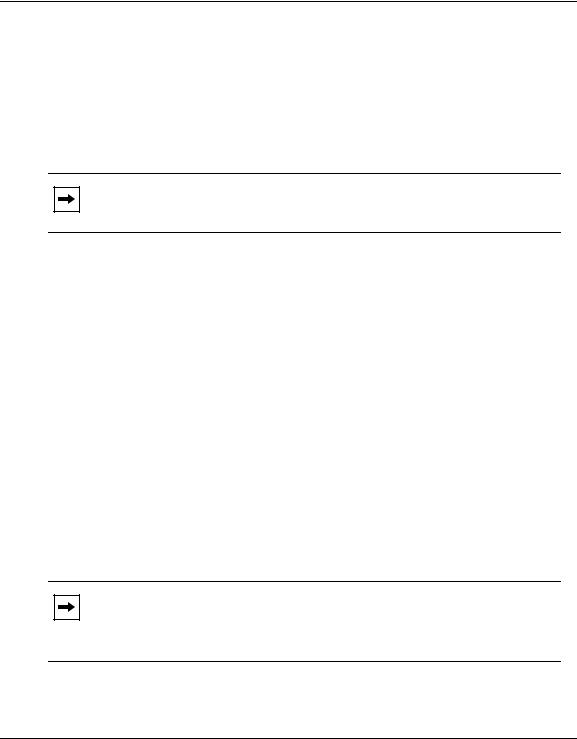
Configuring Remote Access for AN and Passport ARN Routers
The router sends the BootP request through all serial ports at approximately the same time, using the following protocols:
•Nortel Networks Standard Point-to-Point Protocol (PPP) using high-level data link control (HDLC) encapsulation
•Frame Relay Annex D
•Frame Relay Local Management Interface (LMI)
•Frame Relay Annex A
Note: The upstream router must have a circuit running Nortel Networks Standard PPP using HDLC or a frame relay permanent virtual circuit (PVC).
If the AN/ANH and ARN router does not receive a response to the first BootP request, it issues a second request.
If the AN/ANH or ARN router does not receive a response in approximately four minutes, it boots the image and configuration files in its local file system, as described in “Local Boot Process” on page 1-12.
3.The first interface on the upstream router to receive the BootP request responds.
4.The upstream router obtains the IP address of the AN/ANH or ARN router’s serial interface. The protocol configuration of the upstream router determines whether it calculates or requests the IP address, as follows:
--A frame relay PVC in direct access mode or a Nortel Networks Standard PPP interface calculates the IP address by adding 1 to the IP address of the interface that received the request.
For example, in Figure 1-1, the upstream router’s interface address is 192.32.1.1. This means that the upstream router calculates 192.32.1.2 as the AN/ANH or ARN router’s IP address.
Note: If the IP address plus 1 equals a broadcast address, the upstream router calculates the IP address by subtracting 1. For example, if the IP address of the upstream router’s interface is 7.255.255.254, the IP address of the AN/ANH or ARN router is 7.255.255.253.
1-6 |
308614-14.20 Rev 00 |

Understanding Tools and Options
AN/ANH/ARN router
|
|
|
|
|
|
|
|
|
|
|
|
|
|
|
|
|
|
|
|
|
|
|
|
|
|
|
|
|
|
|
|
|
|
|
|
|
|
|
|
|
|
BOOTP request |
|
|
|
|
|
|
|
|
BOOTP response with |
|||||||||||
|
|
|
|
|
|
|
|
|||||||||||||
|
|
|
|
|
|
|
|
|
|
|
|
|
|
IP address 192.32.1.2 |
||||||
|
|
|
|
|
|
|
|
|
|
|
|
|
|
|
|
|
|
|
|
|
|
|
|
|
|
|
|
|
|
|
|
|
|
|
|
|
|
|
|
|
|
|
|
|
|
|
|
|
|
|
|
|
|
|
|
|
|
|
|
|
|
|
Upstream router
IP address 192.32.1.1
NPA0001A
Figure 1-1. Calculating an IP Address
(Direct Access PVC or Standard PPP)
--A frame relay PVC in group access mode refers to its BootP client interface table to find an associated IP address for the AN/ANH or ARN router.
Note: The BootP client interface table contains a data link connection identifier (DLCI) and IP address pair for each PVC. You use Site Manager to create this table when you follow the instructions for setting up routing paths in Chapter 3.
For example, in Figure 1-2, the AN/ANH or ARN router sends BootP requests for its IP address. The upstream router receives the request on PVC 31. The upstream router determines the DLCI, refers to DLCI 31 in the BootP client interface table, finds the IP address, and sends a BootP response containing the IP address back to PVC 31.
308614-14.20 Rev 00 |
1-7 |
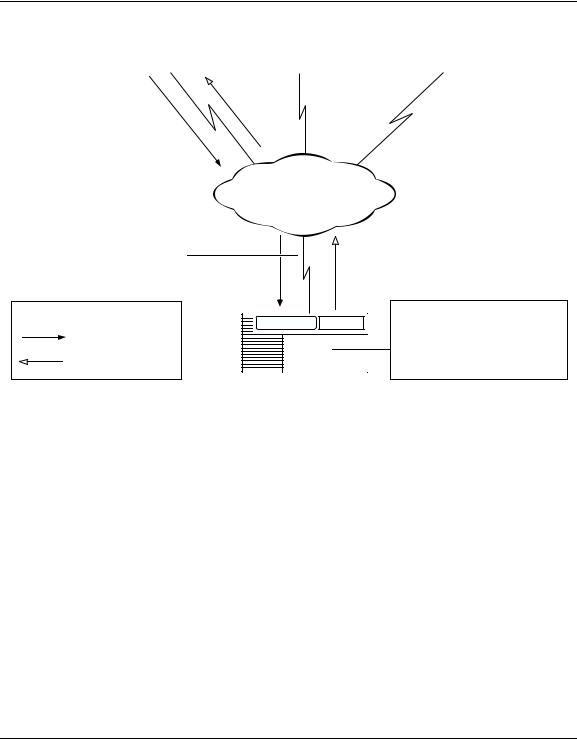
Configuring Remote Access for AN and Passport ARN Routers
AN/ANH/ARN |
Booting router 2 |
|
Booting router 3 |
|
|
|
|
|
|
|
|
|
|
|
|
|
|
|
|
|
|
|
|
|
PVC 32 |
|
PVC 31 |
PVC 33 |
Frame Relay
Circuit containing PVC 31, 32, 33 (for virtual connections to the three routers)
Key
BOOTP request
BOOTP response
BOOTP Client Interface Table:
|
|
|
|
|
|
DLCI 31 |
192.32.1.2 |
|
|
|
|
|
|
||
|
|
|
|
|
|
||
|
|
|
|
|
|
||
|
|
|
|
|
|
DLCI 32 |
192.32.1.3 |
|
|
|
|
|
|
DLCI 33 |
192.32.1.4 |
|
|
|
|
|
|
|
|
Upstream router
NPA0002A
Figure 1-2. Requesting an IP Address from the BootP Server (Group Access PVC)
5.The upstream router sends the IP address and subnet mask to the AN/ANH or ARN router in a BootP response message.
6.The AN/ANH or ARN router assigns the IP address and subnet mask to any serial interface that receives a BootP response.
7.The AN/ANH or ARN router stores these IP addresses, along with the IP address of the next-hop router, in RAM.
If more than one serial interface receives a BootP response, the AN/ANH or ARN router assigns an IP address to each interface.
1-8 |
308614-14.20 Rev 00 |
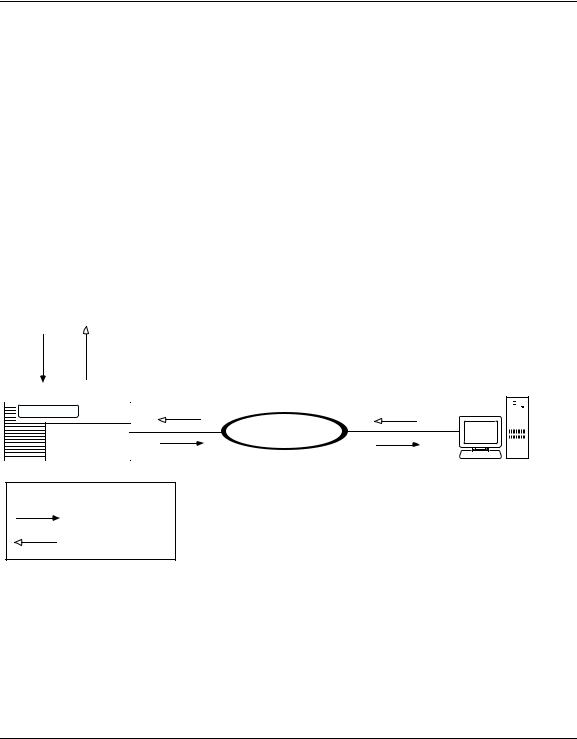
Understanding Tools and Options
Obtaining the Kernel and Configuration Files
With a known IP address, an AN/ANH and ARN router can obtain its operating-system kernel and configuration files over the network. The procedure is the same for EZ-Install, Netboot, and Directed Netboot.
1.The router sends a BootP request for the path names of the startup files.
The router issues the request simultaneously through all serial (COM), Ethernet, and token ring (ARN only) interfaces that have IP addresses. The router issues this request periodically for approximately 3 minutes, regardless of whether a cable is connected.
2.A BootP server responds to the router’s request with the directory path names (Figure 1-3).
AN/ANH/ARN
|
|
|
|
|
|
|
|
|
|
|
Pathnames |
BOOTP |
|
|
|
|
|
|
|
|
|
|
|
|
|
|
|
|
|
|
|
|
|
||
|
|
|
|
|
|
|
|
|
|
|
|
|
|
|
|
||
|
Upstream router |
|
|
|
|
server |
|
|
|
|
|
||||||
|
|
|
|
|
|
|
|
|
|
|
|
|
|
|
|
|
|
|
|
|
|
|
|
|
|
|
|
|
|
|
|
|
|
|
|
|
|
|
|
|
|
|
|
|
|
|
|
|
|
|
|
|
|
|
|
|
|
|
|
|
|
|
|
|
|
|
|
|
|
|
|
Corporate backbone
Key
BOOTP request
BOOTP response
NPA0003A
Figure 1-3. Obtaining the Path Names of the Kernel and Configuration Files
The first router interface that processes the BootP response acts as the TFTP client in the remaining steps.
3. The router stops sending BootP requests.
308614-14.20 Rev 00 |
1-9 |

Configuring Remote Access for AN and Passport ARN Routers
4.The router sends a TFTP request for the configuration file.
5.The BootP server uses TFTP to transfer the configuration file (Figure 1-4).
AN/ANH/ARN
|
Configuration file |
|
Corporate backbone |
Upstream router |
BOOTP server |
Key |
BOOTP response |
TFTP request
TFTP transfer
NPA0004A
Figure 1-4. Obtaining the Configuration File
6.The router sends a TFTP request for the kernel file.
7.The BootP server uses TFTP to transfer the kernel file (Figure 1-5).
1-10 |
308614-14.20 Rev 00 |
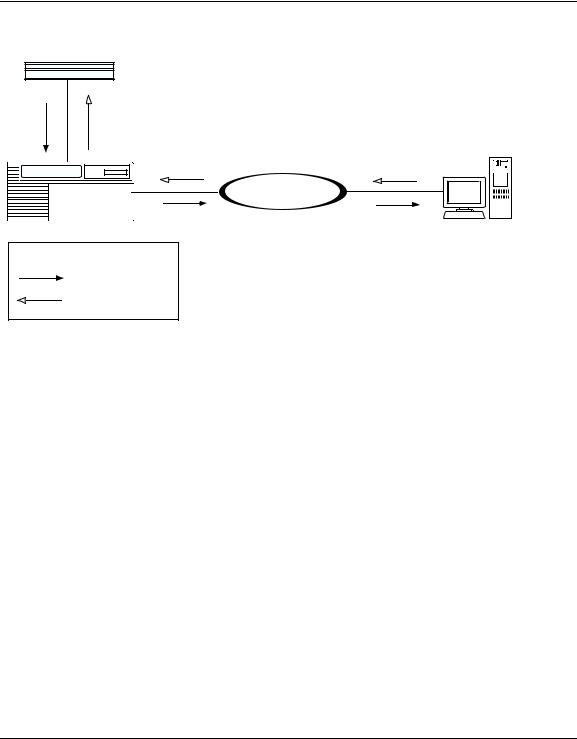
Understanding Tools and Options
AN/ANH/ARN
Kernel
Corporate backbone
Upstream router |
BOOTP server |
Key
TFTP request
TFTP transfer
NPA0005A
Figure 1-5. Obtaining the Kernel File
8.The router boots the kernel.
9.The router uses TFTP to obtain application and string files as it needs them.
10.The router begins bridging and routing network traffic as specified in the configuration file.
The AN/ANH, or ARN router can continue to request files, even after it begins bridging and routing traffic.
If a failure occurs in steps 1 through 8, the AN/ANH or ARN router attempts to boot locally.
308614-14.20 Rev 00 |
1-11 |
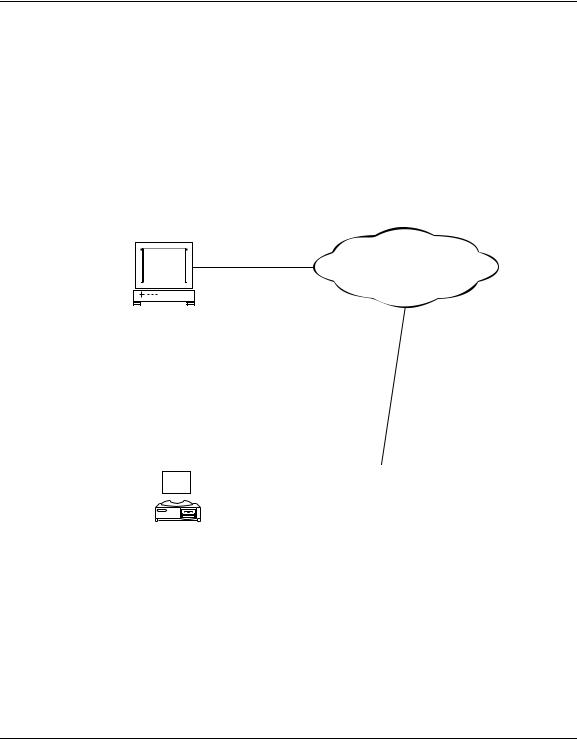
Configuring Remote Access for AN and Passport ARN Routers
Local Boot Process
When the AN/ANH and ARN routers boot locally, they read the kernel, application, and string files embedded in the an.exe or arn.exe software image file on the local PCMCIA flash memory card.
When you use Local Boot as the initial boot option, you boot a default (generic) configuration file. You must then run the Quick-Start installation script to customize the default configuration file. Running the installation script establishes an IP network interface between the router and a Site Manager workstation (Figure 1-6).
IP address = 192.32.10.12
Corporate IP network
Site Manager
workstation
ASCII console or PC |
AN/ANH/ARN |
|
|
|
|
|
|
|
|
|
|
|
|
|
|
|
|
|
|
|
|
|
|
|
|
|
|
|
|
|
|
|
|
|
|
|
|
|
|
|
|
|
|
|
Console port |
Ethernet port |
||||
|
|
|
|
IP address = 192.32.156.7 |
||
|
|
|
|
Subnet mask = 255.255.255.0 |
||
|
|
|
|
|
|
NPA0006A.EPS |
Figure 1-6. Establishing an IP Network Interface
Appendix C briefly describes the procedure for customizing the default configuration file, provides worksheets for preparing to run the procedure, and explains how to begin the Quick-Start installation script.
1-12 |
308614-14.20 Rev 00 |
